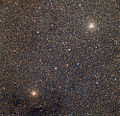| NGC 6522 | |
|---|---|
 | |
| Observation data (J2000 epoch) | |
| Constellation | Sagittarius |
| Right ascension | 18h 03m 34.1s[1] |
| Declination | −30° 02′ 2.3″[1] |
| Distance | 25.1 kly (7.7 kpc)[2] |
| Apparent magnitude (V) | 8.3[3] |
| Apparent dimensions (V) | 16.4'[3] |
| Physical characteristics | |
| Mass | 3.00×105[2] M☉ |
| Metallicity | = –1.34[2] dex |
| Estimated age | 12.0 Gyr[4] |
| Other designations | GCl 82, C 1800-300[1] |
NGC 6522 is a globular cluster in the constellation Sagittarius. It is apparent magnitude 8.3, and diameter 16.4 arc minutes, and class VI with stars 16th magnitude and dimmer. It was discovered by William Herschel on June 24, 1784. It is centered in a region of the sky known as Baade's Window.[1][3]
NGC 6522 is possibly the oldest star cluster in the Milky Way,[5] with an age of more than 12 billion years.[6]
Gallery
[edit]-
The globular clusters NGC 6528 (lower left) is close to NGC 6522 (upper right)
-
The cluster is located in Baade's Window, a region of night sky that is not clouded by dust from the Milky Way.
References
[edit]- ^ a b c d "SIMBAD Astronomical Database". Results for NGC 6522. Retrieved 2011-03-13.
- ^ a b c Boyles, J.; et al. (November 2011), "Young Radio Pulsars in Galactic Globular Clusters", The Astrophysical Journal, 742 (1): 51, arXiv:1108.4402, Bibcode:2011ApJ...742...51B, doi:10.1088/0004-637X/742/1/51, S2CID 118649860.
- ^ a b c "NGC 6522". Retrieved 2020-09-23.
- ^ Koleva, M.; et al. (April 2008), "Spectroscopic ages and metallicities of stellar populations: validation of full spectrum fitting", Monthly Notices of the Royal Astronomical Society, 385 (4): 1998–2010, arXiv:0801.0871, Bibcode:2008MNRAS.385.1998K, doi:10.1111/j.1365-2966.2008.12908.x, S2CID 17571531
- ^ "VLT-FLAMES Analysis of 8 giants in the Bulge Metal-poor Globular Cluster NGC 6522: Oldest Cluster in the Galaxy?" by B. Barbuy et al., 2009
- ^ "The universe's first stars were whirling dervishes", New Scientist by David Shiga, 30 April 2011, p. 20. "Imprints of fast-rotating massive stars in the Galactic Bulge" by Cristina Chiappini et al., Nature 472, pp. 454–457 (28 April 2011).
External links
[edit] Media related to NGC 6522 at Wikimedia Commons
Media related to NGC 6522 at Wikimedia Commons- NGC6522, Galactic Globular Clusters Database page
![{\displaystyle {\begin{smallmatrix}\left[{\ce {Fe}}/{\ce {H}}\right]\end{smallmatrix}}}](https://wikimedia.org/api/rest_v1/media/math/render/svg/4c0821bd80891e071c08e7c7ee8e022baedf522c)


Well, that’s interesting to know that Psilotum nudum are known as whisk ferns. Psilotum nudum is the commoner species of the two. While the P. flaccidum is a rare species and is found in the tropical islands. Both the species are usually epiphytic in habit and grow upon tree ferns. These species may also be terrestrial and grow in humus or in the crevices of the rocks.
View the detailed Guide of Psilotum nudum: Detailed Study Of Psilotum Nudum (Whisk Fern), Classification, Anatomy, Reproduction